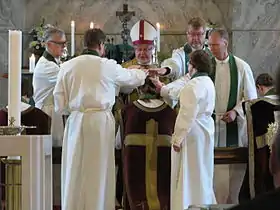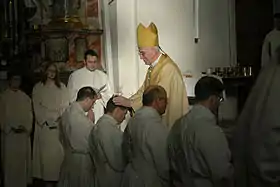Laying on of hands
The laying on of hands is a religious practice. In Judaism semikhah (Hebrew: סמיכה, "leaning [of the hands]"[1]) accompanies the conferring of a blessing or authority.

In Christian churches, this practice is used as both a symbolic and formal method of invoking the Holy Spirit primarily during baptisms and confirmations, healing services, blessings, and ordination of priests, ministers, elders, deacons, and other church officers, along with a variety of other church sacraments and holy ceremonies.
The practice of laying on of hands is also used in Navajo religious ceremonies.[2]
Jewish tradition
The laying on of hands was an action referred to on numerous occasions in the Hebrew Bible to accompany the conferring of a blessing or authority. Moses ordained Joshua through semikhah—i.e. by the laying on of hands: Num 27:15–23, Deut 34:9. The Bible adds that Joshua was thereby "filled with the spirit of wisdom". Moses also ordained the 70 elders (Num 11:16–25). The elders later ordained their successors in this way. Their successors in turn ordained others. This chain of hands-on semikhah continued through the time of the Second Temple, to an undetermined time. The exact date that the original semikhah succession ended is not certain. Many medieval authorities believed that this occurred during the reign of Hillel II, circa 360 CE.[3] However, it seems to have continued at least until 425 CE when Theodosius II executed Gamaliel VI and suppressed the Patriarchate and Sanhedrin.
Christian traditions


In the New Testament the laying on of hands was associated with the receiving of the Holy Spirit (see Acts 8:14–19). Initially the Apostles laid hands on new believers as well as believers (see Acts 6:5–6).
The New Testament also associates the laying on of hands with the conferral of authority or designation of a person to a position of responsibility. (See Acts 6:6, Acts 13:3; and 1 Timothy 4:14. Also possibly Acts 14:23, where "ordained"—Greek: χειροτονήσαντες—may be translated "extended the hand".) The use of the laying on of hands for the ordination of church officers has continued in many branches of Christianity.
Anglicanism
Laying on of hands is part of Anglican confirmation,[4] anointing of the sick,[5] and other parts of liturgy and pastoral offices.
Baptists
Baptist churches, the laying on of hands takes place after a believer's baptism.[6] Southern Baptist Christians employ the laying on of hands during the ordination of clergymen (such as deacons, assistant, and senior pastors) as well as situations of calling for divine healing.
Catholicism
In the Roman Catholic Church, the practice continued and is still used in a wide variety of church ceremonies, such as during confirmation.
Eastern Christianity
In Eastern Christianity, laying on of hands is used for the ordination (called cheirotonia) of the higher clergy (bishops, priests and deacons), and is also performed at the end of the sacrament of unction.
Evangelicalism
In Evangelical Christianity, the laying on of hands takes place for pastoral ordination. [7] In Baptists churches, it takes place after believer's baptism. [8] This is one of the two points which was added in the 1689 Baptist Confession of Faith in 1742. [9][10] In Pentecostals churches, this gesture takes place during prayers for faith healing [11]
Mormonism
Members of The Church of Jesus Christ of Latter-day Saints believe the restoration of Christ's priesthood came about by the laying on of hands by John the Baptist to Joseph Smith and Oliver Cowdery, and laying on of hands is seen as a necessary part of confirmation and ordination to the Aaronic and Melchizedek priesthoods.
Pentecostalism
Pentecostal Christians practice the laying on of hands as part of prayer for divine healing and the anointing of the sick.[12]
State use
The laying on of hands, known as the royal touch, was performed by kings in England and France, and was believed to cure scrofula (also called "King's Evil" at the time), a name given to a number of skin diseases. The rite of the king's touch began in France with Robert II the Pious, but legend later attributed the practice to Clovis as Merovingian founder of the Holy Roman kingdom, and Edward the Confessor in England. The belief continued to be common throughout the Middle Ages but began to die out with the Enlightenment. Queen Anne was the last British monarch to claim to possess this divine ability, though the Jacobite pretenders also claimed to do so. The French monarchy maintained the practice up until the 19th century. The act was usually performed at large ceremonies, often at Easter or other holy days.
See also
Notes
- https://biblehub.com/str/hebrew/5564.htm
- Lewton, Elizabeth L.; Bydone, Victoria (1 December 2000). "Identity and Healing in Three Navajo Religious Traditions: Sa'ah Naagháí Bik'eh Hózho". Medical Anthropology Quarterly. 14 (4): 476–497. doi:10.1525/maq.2000.14.4.476. ISSN 1548-1387. PMID 11224977.
- Nachmanides, Sefer Hazekhut, Gittin ch 4; Rabbenu Nissim, ibid; Sefer Haterumot, Gate 45; R Levi ibn Haviv, Kuntras Hasemikhah.
- "for example: Book of Alternative Services – Anglican Church of Canada, p. 628".
- http://stmarks.byethost9.com/ for example: Book of Alternative Services – Anglican Church of Canada, p. 555
- John H. Y. Briggs, A Dictionary of European Baptist Life and Thought, Wipf and Stock Publishers, USA, 2009, p. 296
- Walter A. Elwell, Evangelical Dictionary of Theology, Baker Academic, USA, 2001, p. 678
- John H. Y. Briggs, A Dictionary of European Baptist Life and Thought, Wipf and Stock Publishers, USA, 2009, p. 296
- William H. Brackney, Historical Dictionary of the Baptists, Scarecrow Press, USA, 2009, p.525-526
- Bill J. Leonard, Baptists in America, Columbia University Press, USA, 2005, p. 76
- Christopher A. Stephenson, Types of Pentecostal Theology: Method, System, Spirit, OUP USA, USA, 2012, p. 64
- Christopher A. Stephenson, Types of Pentecostal Theology: Method, System, Spirit, OUP USA, USA, 2012, p. 64
References
- New Bible Dictionary (ISBN 0-85110-630-7)
- Parry, Ken; Melling, David, eds. (1999). The Blackwell Dictionary of Eastern Christianity. Malden, MA.: Blackwell Publishing. ISBN 978-0-631-23203-2.
- Swete, H.B. "Laying on of hands". Archived from the original on 2010-09-03. Retrieved 2007-10-15.
- "Imposition of Hands". Catholic Encyclopedia.
- "Ordination". Jewish Encyclopedia.
- Scott, Gini Graham (2002). The Complete Idiot's Guide to Shamanism. Alpha Books. ISBN 978-0-02-864364-9.

